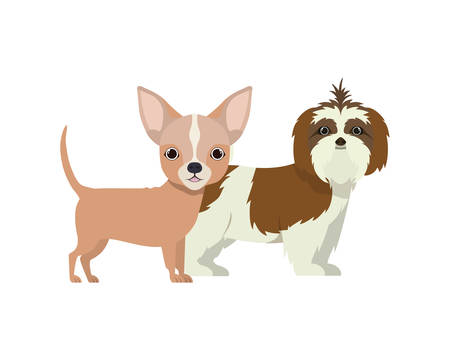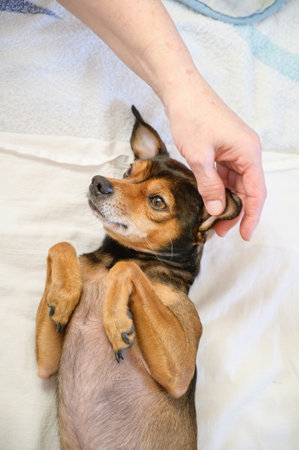Understanding Your Small Pet’s Coat Type
Before you even start shopping for brushes and combs, it’s essential to understand your small pet’s unique coat type. Different breeds and species—whether you have a fluffy bunny, a smooth-coated guinea pig, or a silky-furred hamster—each have their own grooming needs. For example, rabbits can have either short or long hair, with Angoras requiring much more frequent brushing than a standard short-haired bunny. Guinea pigs often come in varieties like Abyssinian, which sports rosettes and swirls, or the Peruvian with flowing locks that tangle easily. Hamsters typically have finer fur but can still develop mats if not cared for properly. Knowing the specific characteristics of your pet’s coat helps you choose grooming tools that won’t just keep them looking cute, but will also support their skin health and overall comfort. By observing your small animal’s fur texture and growth patterns, you’ll be better equipped to select brushes and combs designed for their unique needs, making grooming a stress-free and bonding experience for both of you.
Brushes: Navigating Size, Bristle Type, and Purpose
When it comes to grooming your small pet—whether its a rabbit, guinea pig, hamster, or ferret—the right brush makes all the difference. Not only does a well-chosen brush help keep your pets coat healthy and shiny, but it also turns grooming into a positive bonding experience. But with so many types of brushes on the market, how do you know which one is best for your tiny companion? Lets break down the main styles of brushes and their specific uses to make your selection easier.
Main Types of Brushes for Small Pets
| Brush Type | Description | Best For | Pros | Cons |
|---|---|---|---|---|
| Slicker Brush | Features fine, short wires close together on a flat surface. | Detangling mats in medium to long fur (e.g., rabbits, long-haired guinea pigs). | Removes tangles efficiently; stimulates skin. | Can be harsh if used too vigorously; not ideal for very delicate or short coats. |
| Pin Brush | Has widely spaced pins with rounded tips. | Pets with longer hair that needs gentle detangling without static (e.g., Angora breeds). | Gentle on fur; less likely to irritate sensitive skin. | Not as effective at removing deep mats or undercoat. |
| Bristle Brush | Uses natural or synthetic bristles packed closely together. | Smoothing short-haired pets’ coats (e.g., rats, mice, short-haired hamsters). | Great for sensitive skin; distributes natural oils for shine. | Ineffective on thick mats or dense undercoats. |
| Rubber Brush/Grooming Glove | Soft rubber nubs or glove-style design for hand grooming. | Pets who are skittish about traditional brushes; effective on short fur and during shedding seasons. | Makes grooming feel like petting; easy to clean; massages skin gently. | May not reach deeper layers of dense fur; limited effectiveness on tangles. |
Choosing Based on Your Pet’s Needs
The safest and most effective brush depends on your small pet’s coat type and temperament. For example, slicker brushes can be too harsh for tiny pets with thin skin but are great for tackling tangles in long-haired breeds when used gently. Pin brushes offer a softer touch for regular maintenance, while bristle brushes are perfect for finishing touches and distributing natural oils. Rubber brushes or grooming gloves are often the top choice for first-time groomers or pets who dislike traditional tools—they turn grooming time into a soothing ritual rather than a struggle. Always match the size of the brush to your pet’s body: oversized tools can be intimidating or even dangerous for petite companions. When in doubt, start with the gentlest option and observe how your pet reacts—comfort always comes first!

3. Combs: When and Why to Use Them
Combs are essential grooming tools for small pets, especially when it comes to dealing with tangles, shedding, and matting. Unlike brushes, which generally focus on smoothing the coat’s surface and distributing natural oils, combs dive deeper into the fur to untangle knots and remove loose hair that can cause mats. This is particularly important for small animals like rabbits, guinea pigs, and certain breeds of hamsters or ferrets whose soft, dense coats are prone to clumping if not groomed regularly. The key is knowing when to reach for a comb—right after brushing or whenever you notice small tangles forming. Using a comb helps prevent mats from getting worse, which can be uncomfortable or even painful for your pet.
Choosing the Right Comb Materials
The material of the comb matters more than most people realize. Stainless steel combs are popular in the U.S. because they’re durable, rust-resistant, and easy to clean—ideal for pet owners who want a low-maintenance tool that lasts. Plastic combs are lighter and often more affordable but may break easily or generate static, which can be unpleasant for some pets. Some premium options feature rounded teeth or anti-static coatings to maximize comfort and minimize snagging.
Tooth Spacing: Fine vs. Wide-Toothed Combs
Tooth spacing plays a major role in how effective a comb will be for your small pet’s specific coat type. Fine-toothed combs are perfect for short-haired animals or detail work around delicate areas like the face and ears; they excel at picking up tiny bits of debris and smoothing down fine fur. Wide-toothed combs are better suited for pets with thicker or longer coats, as they can move through dense fur without pulling uncomfortably or breaking hairs. Many American pet parents find that having both types on hand lets them tailor their grooming routine depending on their pet’s unique needs.
Pro Tip: Start Slow and Gentle
No matter which type of comb you choose, always begin grooming sessions slowly and gently—especially if your pet isn’t used to being combed yet. Positive associations with grooming tools go a long way toward making regular care stress-free for both you and your furry friend.
4. Ergonomics and Comfort for You and Your Pet
When it comes to grooming your small pet, comfort and safety are just as important as the effectiveness of the brush or comb. An ergonomic tool not only makes the grooming process smoother for your pet but also ensures that you, as the owner, can handle longer sessions without discomfort or strain. Below, we explore key features to look for in brushes and combs designed with both human and animal comfort in mind.
Handle Design: Grip Matters
A well-designed handle reduces hand fatigue and gives you better control. Look for brushes with soft, non-slip grips, especially if you have arthritis or plan on frequent grooming. Curved or contoured handles often fit more naturally in the palm, making repetitive motions less tiring. Some brushes even feature thumb rests or flexible necks for added maneuverability.
Brush Size: Matching Pet and Tool
The size of the brush should match your pet’s size—not too big to overwhelm them, not too small to be ineffective. A petite brush head is ideal for rabbits, guinea pigs, hamsters, and other small pets, allowing you to reach under legs and around ears with ease. Oversized tools may cause anxiety or accidental injury.
| Feature | Benefit for Owner | Benefit for Pet |
|---|---|---|
| Soft Grip Handle | Reduces hand fatigue | Allows gentle pressure application |
| Padded Backing | Makes brushing comfortable to hold | Cushions skin during grooming |
| Flexible Head | Easier to maneuver around body contours | Less pulling on fur or skin |
| Appropriate Brush Size | Better precision and control | Minimizes stress from large tools |
| Smooth Rounded Tips | No accidental pokes while brushing | Prevents skin irritation or scratches |
Stress-Free Grooming Features
Modern grooming tools come with features designed to minimize stress for pets—think quiet operation (no rattling parts), easy-to-clean bristles, and anti-static materials. Brushes with retractable bristles make hair removal a breeze, so you can stay focused on bonding rather than cleanup. Always choose products labeled “pet-safe” and avoid anything with sharp edges or harsh metal tines.
Your Comfort Equals Your Pet’s Comfort
A calm, confident owner makes all the difference during grooming sessions. By investing in ergonomically designed tools that fit comfortably in your hand and match your pet’s size, you create a safer, more enjoyable experience for both you and your furry friend. Remember: happy hands lead to happy pets!
5. Safety Tips: Avoiding Over-Grooming and Skin Irritation
Grooming your small pet is important, but it’s just as crucial to do it safely. Over-grooming can lead to skin irritation, bald spots, or even stress for your little companion. So how often should you groom? For most small pets like rabbits, guinea pigs, and hamsters, a gentle brush once or twice a week is enough. Long-haired breeds might need more frequent attention, but always be gentle and watch how your pet reacts.
Spotting Sensitive Skin
Keep an eye out for signs of sensitive skin during grooming sessions. If your pet flinches, tries to escape, or you notice redness, flakiness, or bumps, these are red flags. Some pets have delicate skin that can’t handle rough bristles or too much brushing. In these cases, switch to a softer brush or comb and reduce the frequency.
Normal Shedding vs. Problem Areas
It’s normal for pets to shed, especially when seasons change. However, there’s a difference between healthy shedding and problematic hair loss. Normal shedding usually happens evenly across the body and doesn’t expose bare patches of skin. If you see thinning fur in concentrated areas or bald spots, this could signal an underlying health issue or over-grooming.
Practical Tips for Safe Grooming
Always start by brushing gently and watching your pet’s reaction. Set a routine—weekly for short-haired pets and two to three times per week for long-haired ones. Never force a grooming session if your pet seems stressed; take breaks and use treats as positive reinforcement. Regularly clean your brushes and combs to avoid bacteria buildup, which can also irritate sensitive skin. And if you notice persistent irritation or unusual hair loss, consult your veterinarian to rule out allergies or skin conditions.
6. How to Introduce Grooming Tools to Your Pet
Getting your small pet comfortable with grooming tools is a key step in making the experience enjoyable for both of you. Instead of turning brushing or combing into a dreaded chore, you can use positive reinforcement and gradual exposure to help your pet associate these tools with good things—think treats, praise, and quality time together.
Start Slow and Let Curiosity Lead
Begin by simply letting your pet sniff and inspect the brush or comb. Place the tool near their favorite resting spot or during playtime so it becomes part of their everyday environment. If your pet investigates the tool, reward them with a treat or gentle petting. This sets the stage for future interactions by building curiosity instead of fear.
Pair Grooming with Positive Experiences
Associate grooming sessions with moments your pet already enjoys, like after a meal or during cuddle time. Keep initial sessions very short—just a few gentle strokes—and offer plenty of praise and a favorite snack afterwards. The goal is to end each session on a high note, leaving your pet looking forward to the next round.
Watch for Cues and Respect Boundaries
Pay close attention to your pet’s body language. If they seem anxious or try to squirm away, take a break and try again later. For some small pets, certain brushes or combs may feel better than others; don’t be afraid to experiment until you find the right fit. Remember, patience goes a long way in building trust.
Make Grooming a Bonding Ritual
Over time, as your pet becomes more comfortable, you can gradually increase the length of grooming sessions. Talk softly or play calming music to set a relaxing mood. By consistently pairing grooming with affection and rewards, you’ll transform it from a routine task into a meaningful bonding experience that benefits both you and your small companion.


